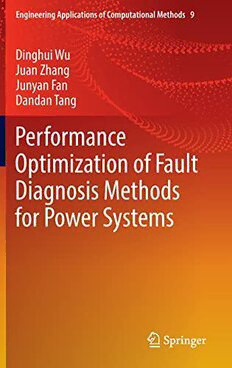Table Of ContentEngineering Applications of Computational Methods 9
Dinghui Wu
Juan Zhang
Junyan Fan
Dandan Tang
Performance
Optimization of Fault
Diagnosis Methods
for Power Systems
Engineering Applications of Computational
Methods
Volume 9
SeriesEditors
LiangGao,StateKeyLaboratoryofDigitalManufacturingEquipment
andTechnology,HuazhongUniversityofScienceandTechnology,
Wuhan,Hubei,China
AkhilGarg,SchoolofMechanicalScienceandEngineering,HuazhongUniversity
ofScienceandTechnology,Wuhan,Hubei,China
ThebookseriesEngineeringApplicationsofComputationalMethodsaddressesthe
numerousapplicationsofmathematicaltheoryandlatestcomputationalornumerical
methodsinvariousfieldsofengineering.Itemphasizesthepracticalapplicationof
thesemethods,withpossibleaspectsinprogramming.Newanddevelopingcompu-
tationalmethodsusingbigdata,machinelearningandAIarediscussedinthisbook
series,andcouldbeappliedtoengineeringfields,suchasmanufacturing,industrial
engineering,controlengineering,civilengineering,energyengineeringandmaterial
engineering.
The book series Engineering Applications of Computational Methods aims to
introduceimportantcomputationalmethodsadoptedindifferentengineeringprojects
toresearchersandengineers.Theindividualbookvolumesintheseriesarethematic.
The goal of each volume is to give readers a comprehensive overview of how the
computational methods in a certain engineering area can be used. As a collection,
the series provides valuable resources to a wide audience in academia, the engi-
neering research community, industry and anyone else who are looking to expand
theirknowledgeofcomputationalmethods.
ThisbookseriesisindexedinboththeScopusandCompendexdatabases.
· · ·
Dinghui Wu Juan Zhang Junyan Fan
Dandan Tang
Performance Optimization
of Fault Diagnosis Methods
for Power Systems
DinghuiWu JuanZhang
SchoolofInternetofThingsEngineering SchoolofInternetofThingsEngineering
JiangnanUniversity JiangnanUniversity
Wuxi,Jiangsu,China Wuxi,Jiangsu,China
JunyanFan DandanTang
SchoolofInternetofThingsEngineering SchoolofInternetofThingsEngineering
JiangnanUniversity JiangnanUniversity
Wuxi,Jiangsu,China Wuxi,Jiangsu,China
NationalKeyResearchandDevelopmentProgramofChina
NationalNaturalScienceFoundationofChina
ISSN 2662-3366 ISSN 2662-3374 (electronic)
EngineeringApplicationsofComputationalMethods
ISBN 978-981-19-4577-9 ISBN 978-981-19-4578-6 (eBook)
https://doi.org/10.1007/978-981-19-4578-6
©TheEditor(s)(ifapplicable)andTheAuthor(s),underexclusivelicensetoSpringerNature
SingaporePteLtd.2023
Thisworkissubjecttocopyright.AllrightsaresolelyandexclusivelylicensedbythePublisher,whether
thewholeorpartofthematerialisconcerned,specificallytherightsoftranslation,reprinting,reuse
ofillustrations,recitation,broadcasting,reproductiononmicrofilmsorinanyotherphysicalway,and
transmissionorinformationstorageandretrieval,electronicadaptation,computersoftware,orbysimilar
ordissimilarmethodologynowknownorhereafterdeveloped.
Theuseofgeneraldescriptivenames,registerednames,trademarks,servicemarks,etc.inthispublication
doesnotimply,evenintheabsenceofaspecificstatement,thatsuchnamesareexemptfromtherelevant
protectivelawsandregulationsandthereforefreeforgeneraluse.
Thepublisher,theauthors,andtheeditorsaresafetoassumethattheadviceandinformationinthisbook
arebelievedtobetrueandaccurateatthedateofpublication.Neitherthepublishernortheauthorsor
theeditorsgiveawarranty,expressedorimplied,withrespecttothematerialcontainedhereinorforany
errorsoromissionsthatmayhavebeenmade.Thepublisherremainsneutralwithregardtojurisdictional
claimsinpublishedmapsandinstitutionalaffiliations.
ThisSpringerimprintispublishedbytheregisteredcompanySpringerNatureSingaporePteLtd.
The registered company address is: 152 Beach Road, #21-01/04 Gateway East, Singapore 189721,
Singapore
Thisbookisdedicatedtoourfamilies,who
havealwaysencouragedandsupportedusto
exploreknowledgeandchaseourdreams.
Preface
Faultdiagnosisofpowersystemsisaprocesstodetect,locateandidentifyavariety
offaultsbyanalyzingpowerdatasuchaselectricalquantityandswitchingquantity
based on professional knowledge of electrical engineering. Timely and accurate
fault diagnosis is conducive to rapid fault removal and reduces the impact of fault
aspossible.Withthedevelopmentofpowersystems,thescaleisexpandedandthe
structureisgettingmoreandmorecomplex,makingthestabilityanalysisofpower
systemsmoreandmoredifficult.Traditionalmodel-basedfaultdiagnosismethodsfor
powersystemsarefacingchallenges,andtherefore,inapplicablefortimelyanalysis,
andtheaccuracyoffaultdiagnosisneedstobeimprovedatthesametime.
Amingtooptimizetheperformanceofexistingmethodsandimprovethespeed
andaccuracyoffaultdiagnosis,amethodologyoffaultdiagnosisforpowersystems
isproposed.Thisbookismainlyfocusedontheperformanceoptimizationoffault
diagnosismethodsforpowersystemsincludingbothmodel-drivenones,suchasthe
convolutionalneuralnetwork,anddata-drivenones,suchasrandommatrixtheory.
Studiesonfaultdiagnosisofpowersystemshavelongbeenthefocusofelectrical
engineersandscientists.Pursuingaholisticapproachtoimprovetheaccuracyand
efficiency of existing methods, the underlying concepts of several algorithms are
introducedandthenfurtherappliedinvarioussituationsforfaultdiagnosisofpower
systems in this book. The primary audience for the book would be the scholars
and graduate students whose research topics include the control theory, applied
mathematics,faultdetectionandsoon.
Wuxi,China DinghuiWu
May2022 JuanZhang
JunyanFan
DandanTang
Acknowledgements ThisbookissupportedbytheNationalNaturalScienceFoundationofChina
withGrantNo.61572237,theNationalKeyResearchandDevelopmentProgramofChinawith
GrantNo.2020YFB1711102and2020YFB1711100.
vii
Contents
1 Introduction ................................................... 1
1.1 BackgroundandSignificance ................................ 1
1.1.1 Background ......................................... 1
1.1.2 Significance ......................................... 2
1.2 BookOrganization ......................................... 3
1.3 Preliminaries .............................................. 4
1.3.1 GaussianFitting ..................................... 4
1.3.2 RandomMatrixTheory ............................... 5
1.3.3 FederatedLearning ................................... 8
References ..................................................... 11
2 Short-Term WindPower Prediction Based on DP-RVESN
Model ......................................................... 13
2.1 Introduction ............................................... 13
2.2 Methodology .............................................. 15
2.2.1 KernelPrincipalComponentAnalysis(KPCA) ........... 15
2.2.2 NetworkStructure ................................... 16
2.2.3 RobustVariationalReasoning .......................... 18
2.3 ProposedHybridForecastingModel .......................... 21
2.4 ExperimentalResultsandAnalysis ............................ 22
2.4.1 DataProcess(DP) .................................... 24
2.4.2 PredictionResults .................................... 27
2.5 Conclusion ................................................ 29
References ..................................................... 32
3 AFaultDetectionMethodforPowerSystemsBasedonRandom
MatrixTheory ................................................. 35
3.1 Introduction ............................................... 35
3.2 FaultDetectionMethodBasedonRandomMatrixTheory ........ 36
3.2.1 ConstructionofRandomMatrixandDataProcessing ..... 36
3.2.2 Fault Detection Method Based on the Maximum
EigenvalueVariationRate ............................. 37
ix
x Contents
3.2.3 DiscussionswiththeOtherMethods .................... 39
3.3 CaseStudies ............................................... 40
3.3.1 Case 1: Effectiveness Verification of the MEVR
MethodUnderThree-PhaseShort-CircuitonBus9 ....... 41
3.3.2 Case 2: Effectiveness Verification of the MEVR
MethodUnderLoadJumpofBus29 .................... 45
3.4 Conclusion ................................................ 48
References ..................................................... 48
4 AFaultLocationMethodforPowerSystemsBasedonRandom
MatrixTheory ................................................. 51
4.1 Introduction ............................................... 51
4.2 FaultLocationMethodBasedonRandomMatrixTheory ........ 52
4.2.1 FaultLocationBasedontheLargestEigenvector ......... 53
4.2.2 DiscussionswiththeOtherMethods .................... 54
4.3 CaseStudy ................................................ 57
4.3.1 Case1:EffectivenessVerificationoftheProposed
MethodforSimpleFault .............................. 58
4.3.2 Case2:EffectivenessVerificationoftheProposed
MethodforSimultaneousMultipleFaults ................ 61
4.3.3 Case3:EffectivenessVerificationoftheProposed
MethodforSuccessiveMultipleFaults .................. 62
4.4 Conclusion ................................................ 65
References ..................................................... 66
5 JointWeightedDomainAdaptationNetworkforBearingFault
Diagnosis ...................................................... 67
5.1 Introduction ............................................... 67
5.2 Preliminaries .............................................. 69
5.2.1 TransferLearningProblem ............................ 69
5.2.2 MMD .............................................. 70
5.2.3 JWDD .............................................. 71
5.3 JWDANforTransferFaultDiagnosis ......................... 73
5.3.1 JWDAN ............................................ 73
5.3.2 TrainingJWDAN .................................... 76
5.4 Experiments ............................................... 78
5.4.1 DataDescription ..................................... 78
5.4.2 ExperimentalSetup .................................. 80
5.4.3 Results ............................................. 81
5.4.4 Hyper-ParametersAnalysis ............................ 83
5.4.5 AblationStudy ...................................... 84
5.5 Conclusion ................................................ 86
References ..................................................... 86
Contents xi
6 Bearing Fault Diagnosis of Wind Motor Based
onShared-FedAvgwithNon-IIDData ............................ 89
6.1 Introduction ............................................... 89
6.2 RelatedKnowledge ......................................... 90
6.2.1 FederatedLearning ................................... 90
6.2.2 IIDandNon-IID ..................................... 92
6.2.3 FaultDiagnosisonClientSideBasedonWPD-CNN ...... 93
6.3 FaultDiagnosisAlgorithmBasedonShared-FedAvg ............ 95
6.4 ExperimentalAnalysis ...................................... 97
6.4.1 ExperimentalData ................................... 98
6.4.2 DifferentDiagnosticStrategies ......................... 99
6.4.3 ExperimentalAnalysis ................................ 100
6.5 Conclusion ................................................ 106
References ..................................................... 106
7 FederatedLearningforRotatingMachineryFaultDiagnosis
withKnowledgeDistillation ..................................... 109
7.1 Introduction ............................................... 109
7.2 RelatedKnowledge ......................................... 110
7.2.1 FederatedLearning ................................... 110
7.2.2 KnowledgeDistillation ............................... 111
7.3 ProposedMethod ........................................... 112
7.3.1 DirichletDataSplittingStrategy ....................... 114
7.3.2 CNNforFaultDiagnosis .............................. 114
7.3.3 PreposedEfficientFaultDiagnosisMethods ............. 114
7.4 Experiments ............................................... 117
7.4.1 Setup ............................................... 117
7.4.2 PerformanceOverviewofFedAvg ...................... 120
7.4.3 EvaluatePerformanceofKD-FedAvg ................... 121
7.4.4 GeneralizationAnalysis ............................... 122
7.5 Conclusion ................................................ 126
References ..................................................... 126

